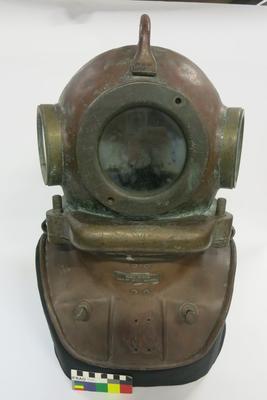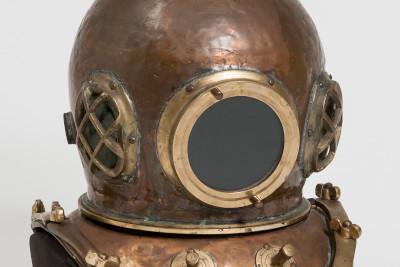Diving Helmet
Production date
1953
Country
Russia
See full details
Object detail
Description
GKS3 Helium/Oxygen Equipment 3 Diving Helmet, c. 1953 (Russian)
Used by the Russian Navy.
Used by the Russian Navy.
Classification
MARITIME TECHNOLOGY Diving Diver's helmet
Production date
1953
Production place
Measurements
H530mm x W360mm x D430mm
Media/Materials description
Copper, brass, glass
Signature/Marks
Manufacturer's name plaque is missing (centre front of corselet): There is a plaque above the missing plaque:3ABOA N3 BMOPBKC-57 No83 Ebin. 1959
VI (Roman Numberal 6) hand etched into the front of the upper neck ring
BRG57 N=83 stamped into the lower neck ring (front right)
VI (Roman Numberal 6) hand etched into the front of the upper neck ring
BRG57 N=83 stamped into the lower neck ring (front right)
History and use
Developed for the Russian Navy in the early 1950s, the GKS3 mixed gas recirculating helmet was capable to depths of sixty (60) to two hundred (200) metres. The helmet had a large neck ring in which the injector system was mounted. The diver carried a metal container on his back that held the Natrium Hydroxide (sodascorb) to clear the exhaled air of CO2.
When the GKS3 helmet was developed its injector was attached to the same place on the helmet as it was with the earlier SKD prototype, right in front of the diver's mouth. American helmets had the injector at the right back of the helmet, just in front of the CO2 absorbent canister. German Draeger helmets have the injector placed in the backpack, just after the CO2 absorbent canister. In 1953 the first GKS3 was taken into service with the Russian Navy, but the earliest manual on GKS3 is dated 1954. Shortly after the GKS3 was succeeded by a modified version known as the GKS3-M.
When the GKS3 helmet was developed its injector was attached to the same place on the helmet as it was with the earlier SKD prototype, right in front of the diver's mouth. American helmets had the injector at the right back of the helmet, just in front of the CO2 absorbent canister. German Draeger helmets have the injector placed in the backpack, just after the CO2 absorbent canister. In 1953 the first GKS3 was taken into service with the Russian Navy, but the earliest manual on GKS3 is dated 1954. Shortly after the GKS3 was succeeded by a modified version known as the GKS3-M.
Associated person
Registration number
H3893




